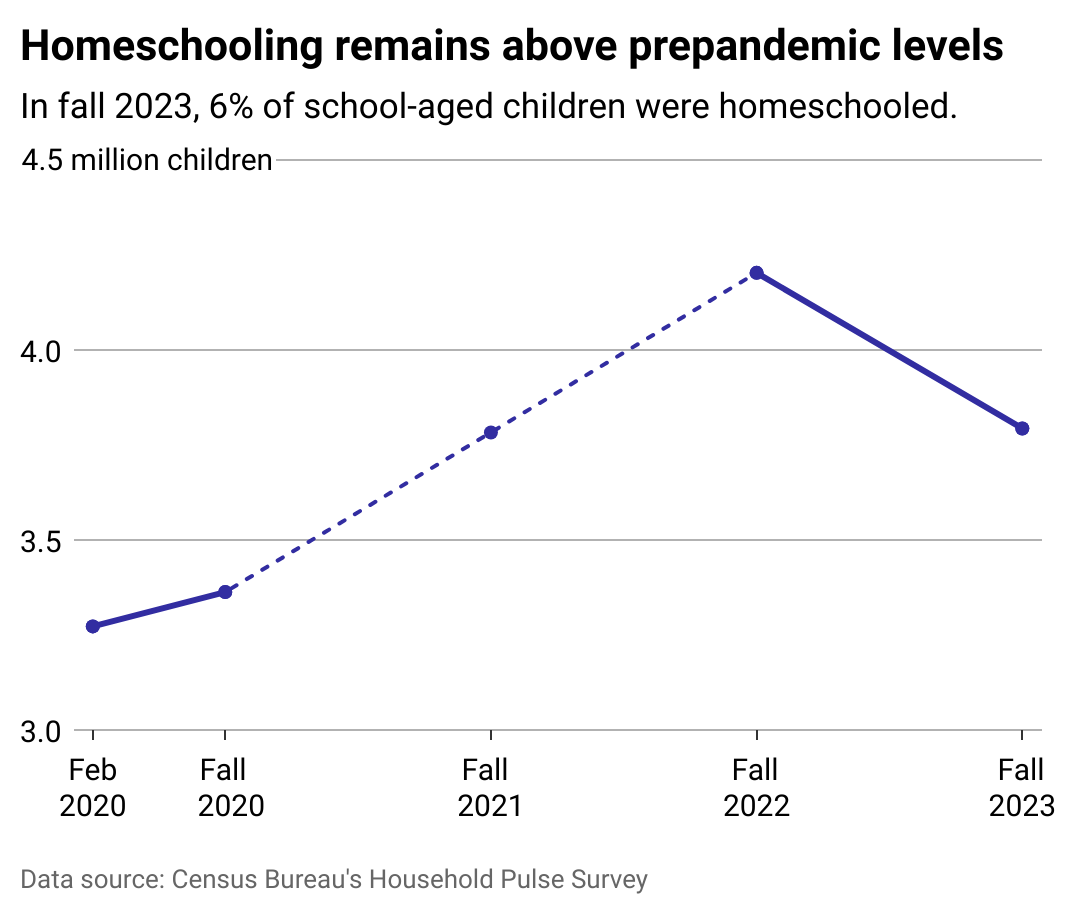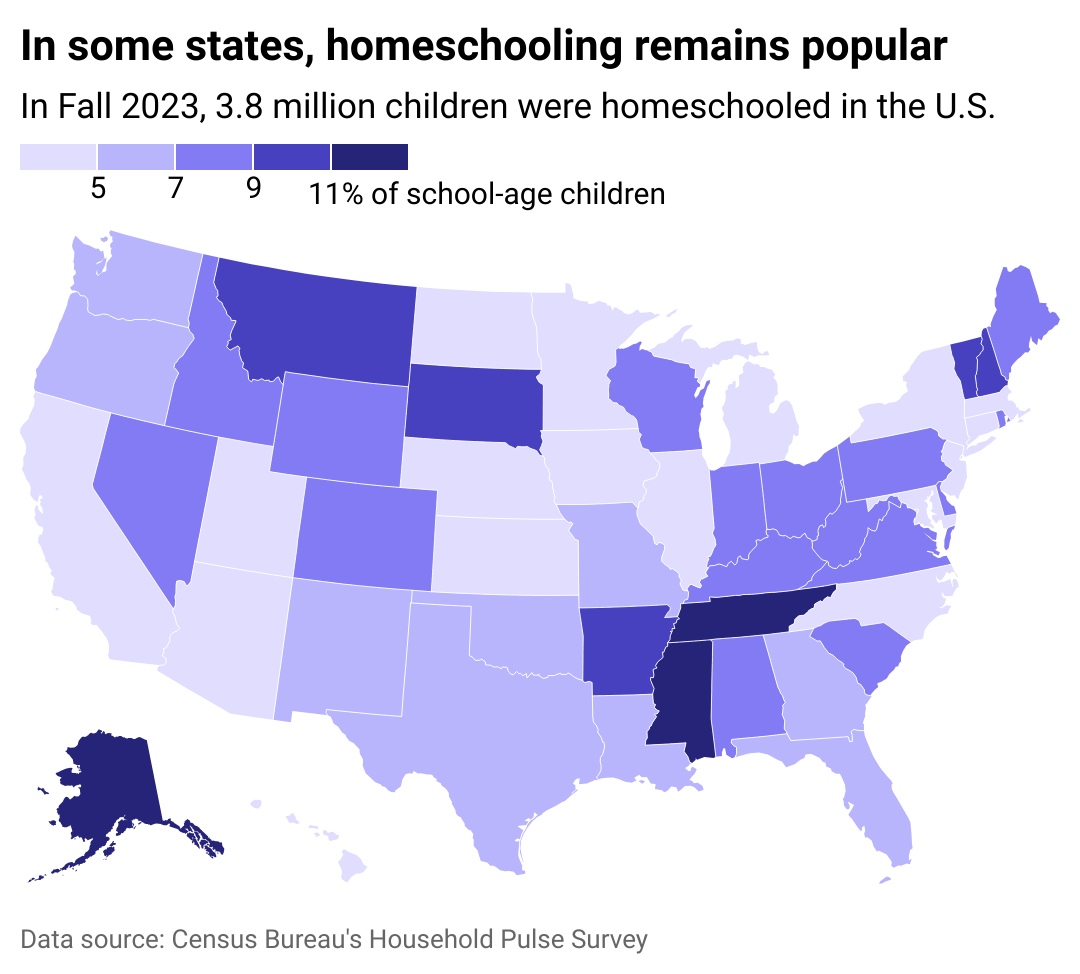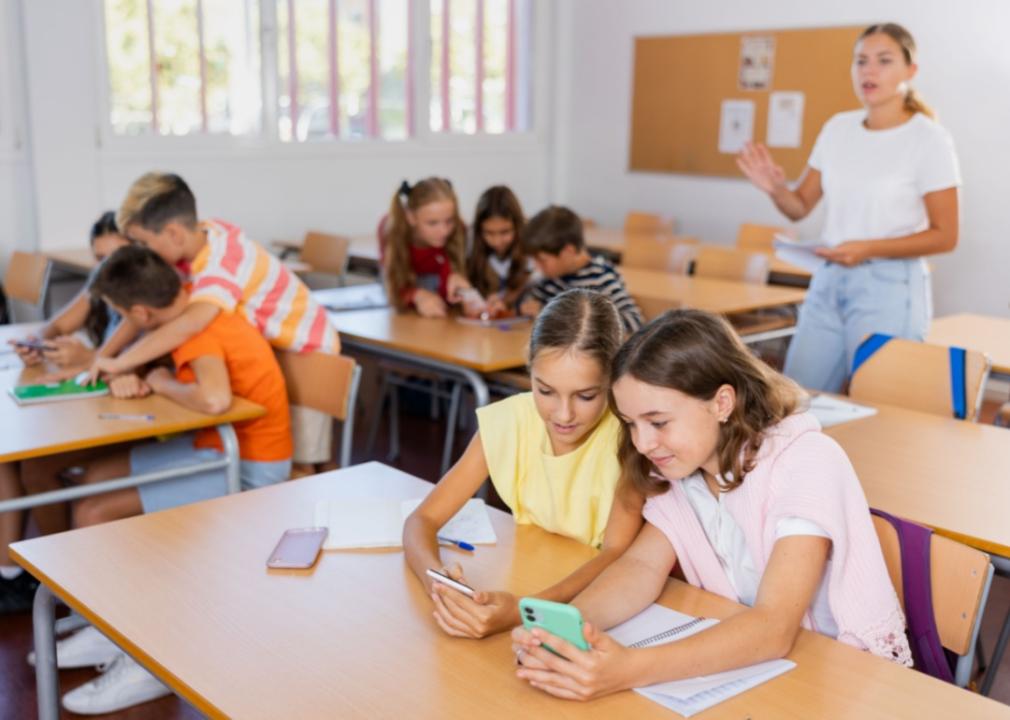After the homeschooling spike post-pandemic, where is the fastest-growing form of education headed?

pics five // Shutterstock
After the homeschooling spike post-pandemic, where is the fastest-growing form of education headed?
Two people sitting together at a table, both smiling warmly as they look at a laptop screen. The person on the left is a younger African American girl wearing a yellow long-sleeved shirt, looking at the laptop with a bright, happy expression. The person on the right, an African American woman, has her hair styled in a natural updo and is wearing a cozy-looking, textured sweater.
After peaking in June 2023, homeschooling rates remain higher than they were four years ago. The sudden increase in homeschooling coincided with the COVID-19 pandemic between 2020 and 2021, when many parents began homeschooling their children as schools shut their doors.
Along with the uptick in homeschooling, pervasive teacher shortages in public schools have contributed to frustrations. Difficulties in hiring new teachers were reported in roughly 9 out of 10 public school districts, with low pay cited as a reason behind the challenge to fill vacancies. With an increase in teachers retiring during the pandemic, many schools increased classroom sizes while schools still remain understaffed.
TeacherCertification.com examined data from the Census Bureau’s Household Pulse Survey to see how homeschooling increased since the first year of the pandemic and where we are today.
A 2022 National Center for Education Statistics report found that nearly half (44%) of public schools had full- or part-time teaching vacancies, with at least 3 in 5 (63%) schools identifying COVID-19 as a cause. One consequence of fewer teachers is larger classroom sizes.
These higher student-teacher ratios go beyond class size to reflect a teacher’s workload and ability to provide one-on-one attention to students. Unsurprisingly, low student-teacher ratios are a strong indicator of student success and engagement. Smaller class sizes can make students feel more comfortable engaging in class and asking for help. They also mean teachers have more bandwidth to mentor students and address issues in an appropriate manner.
Historical data from the NCES shows that pupil-to-teacher ratios in public and private elementary and secondary schools fell from 22.4 students per teacher in 1970 to 15.3 students per teacher in 2019. State policies limiting class sizes and additional funding contributed to reduced class sizes.
Adding more responsibilities to teachers’ workloads can lead to burnout and feeling underpaid. According to a June 2022 Hart Research Associates survey of American Federation of Teachers members, almost 3 in 4 educators reported dissatisfaction on the job in 2022 compared to just 2 in 5 in 2020. Increased homeschooling thus may be a pleasant surprise for many teachers dreaming of smaller class sizes.
![]()

TeacherCertification.com
More parents deciding to homeschool
A line chart showing the growth of homeschooling since the start of the pandemic.
According to the Institute of Education Sciences’ 2019 Homeschooling and Full-Time Virtual Education Rates report, just 1 in 50 school-age children were homeschooled in 1999. The homeschool population grew between 2% and 8% annually for several years—until a sharp increase between 2019 and 2021 during the pandemic. By fall 2021, about 1 in 10 households with school-aged children reported homeschooling their children, nearly double the rate of U.S households that were homeschooling at the beginning of the 2020-21 school year.
According to a survey conducted by the IES between 2018 and 2019, commonly cited reasons for homeschooling included concerns about the school environment, the need to provide moral instruction, the desire to emphasize family life together, dissatisfaction with schools’ academic instruction, and the desire to provide religious instruction.
Homeschooling rates, however, were not uniform across all demographics. The highest increases were seen among Black Americans, with the proportion of Black children being homeschooled increasing fivefold between the beginning and end of the 2019-2020 academic year.
Black families left traditional schooling at high rates to escape the institutional racism in school systems. According to a 2023 article in the Guardian, cited reasons include being “fed up” with Black children being disproportionately punished and the lack of representation in literature and history books.
Homeschooling rates differed by state too. Alaska, Florida, Massachusetts, Nevada, New York, and West Virginia saw at least a 9% increase in homeschooling, while other states experienced no significant change. These differences may be explained by local variations in school policy and COVID-19 infection rates.

TeacherCertification.com
Homeschooling is more common in rural states
A map showing the most recent homeschooling rates in each state.
Homeschooling legislation at the state level ranges from lax to stringent, which may also affect homeschooling rates. For example, at just shy of 15%, Alaska had the highest percentage of school-aged homeschooled children in the U.S. According to state law, parents and legal guardians of children are not required to notify the state, apply for approval, test, submit forms, or have teaching qualifications to teach their children at home.
Mississippi has the second-highest rate of school-aged homeschooled children in the U.S. at almost 14%. Unlike in Alaska, parents and guardians must file for an annual enrollment certificate. There are few other guardrails, including no teaching qualifications, standardized testing requirements, required subjects to be taught, or days for instruction.
By comparison, Kansas has one of the lowest rates of homeschooling in the U.S., with less than 1 in 20 school-aged children being taught at home. It also has stricter homeschooling rules than other states. For example, homeschools must be registered as nonaccredited private schools, teach for around 186 days per year according to a plan and schedule, and test students periodically.
Homeschooling rates also differ based on population density, with children in rural areas around 1.5 times more likely than children living in cities, suburban areas, and towns to be homeschooled, according to a 2019 NCES report.

BearFotos // Shutterstock
What’s next for homeschooling and public education?
A lively classroom scene with students engaged in group activities. In the foreground, two girls are seated at a desk, closely looking at their smartphones with focused expressions.
While homeschooling may have peaked in the 2021-2022 school year, it now seems to be declining. By mid-2022, the number of children homeschooled started to drop, settling at between 5.2% and 6.6%, according to the National Home Education Research Institute.
Incentives for increasing homeschooling exist, such as Florida’s educational voucher program, which can provide up to $8,000 per child in annual taxpayer funding for homeschooling parents. A lack of homeschooling standardization and regulation—with many parents acting as teachers while having no experience in education—may give many parents pause before withdrawing their children from school.
Declining homeschooling rates may not last for long. A 2024 Outschool State of Schooling report found that almost 1 in 5 parents who send their children to public school have become more interested in alternative forms of education like homeschooling since the pandemic.
With a projected decline in elementary and kindergarten teachers over the next decade, students and teachers may face larger class sizes. While most American children will still attend public or accredited private schools, steady increases in homeschooling may lead to mild reductions in class sizes in some areas. With teacher stress and burnout at a high, support for public school teachers and viable opportunities for educational alternatives like homeschooling can help provide all children with the best educational fit.
Story editing by Alizah Salario. Additional editing by Kelly Glass. Copy editing by Janina Lawrence. Photo selection by Ania Antecka.
This story originally appeared on TeacherCertification.com and was produced and distributed in partnership with Stacker Studio.
